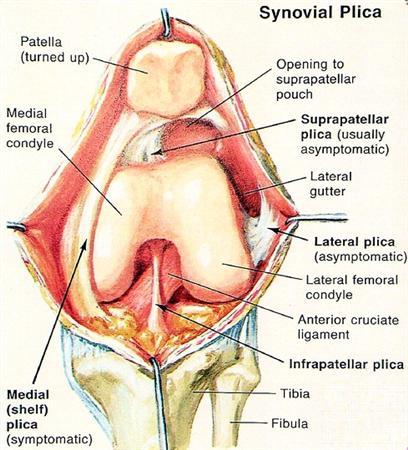Plica Syndrome

Overview
Plica syndrome is a knee condition that causes knee pain and discomfort. It is believed to occur when a part of the protective synovial capsule in the knee, the plica, becomes irritated, generally due to overuse or injury. This irritation inflames the plica, leading to painful symptoms that can limit mobility. The exact prevalence of plica syndrome is unknown, as it often goes undiagnosed because its symptoms can mirror other knee conditions.
Types
Primarily, four types of plicas may be affected—medial, lateral, infrapatellar, and suprapatellar. However, the irritation of the medial plica—situated on the inner side of the knee—is most common in plica syndrome.
Causes
The primary causes of plica syndrome are overuse and injury. Activities that involve repetitive bending and straightening of the knee, such as cycling or running, can lead to plica irritation. Injuries that cause a direct impact to the knee or twist the knee joint may also cause plica syndrome. In rare cases, it may arise when an already present but asymptomatic plica becomes inflamed due to other forms of knee inflammation or arthritis.
Symptoms
The chief symptom of plica syndrome is knee pain, which may worsen when the knee is in motion—walking, running, or climbing stairs, for example. The pain may be localized to the center of the knee or spread over a broader area.
Other common symptoms include:
-
- Increased pain when the knee is straightened after bending it for a time.
-
- Feeling a popping or clicking sensation in the knee.
-
- A feeling of instability or weakness in the knee.
-
- Swelling around the knee joint.
Diagnosis
Plica syndrome is generally diagnosed via a patient’s history and a physical examination by a healthcare provider. Physical tests often involve bending and straightening the knee to assess pain or a catching sensation. Imaging tests like MRI or ultrasound may also be used to assess the plica’s thickness or to rule out other knee conditions.
Treatment Options
Treatment for plica syndrome generally starts with conservative approaches such as rest, ice, compression, and elevation strategies—commonly referred to as RICE therapy. In addition, non-steroidal anti-inflammatory drugs (NSAIDs) may be recommended to alleviate pain and reduce inflammation.
Physical therapy can also be beneficial for strengthening the knee and improving flexibility.
Surgical intervention may be considered if conservative treatments don’t provide relief. Techniques like arthroscopy can remove or reduce the irritated plica to alleviate symptoms.
Living With Plica Syndrome
Living with plica syndrome can present challenges. Here are some tips:
-
- Lifestyle changes: Low-impact exercises like swimming or cycling can maintain fitness levels without putting excess pressure on the knee.
-
- Medication management: Regular, as prescribed, use of NSAIDs can help manage pain and inflammation.
-
- Coping strategies: Heat or cold treatments can alleviate symptoms; heat helps relax muscles while cold can reduce swelling.
Adequate rest is necessary for the healing process. Even after recovery, one must take care not to overstrain the knee to prevent a recurrence.
When to Seek Help
Prompt medical attention must be sought if:
-
- There is severe pain that isn’t relieved by rest or over-the-counter medication.
-
- The knee is visibly swollen or red.
-
- There is a feeling of instability or the knee gives out while walking or standing.
-
- There is noticeable difficulty in moving the knee or a significant reduction in the knee’s range of motion.
Careful management of plica syndrome can ease discomfort and lead to full recovery. If any issues arise, they should be promptly discussed with a healthcare provider for appropriate treatment.
